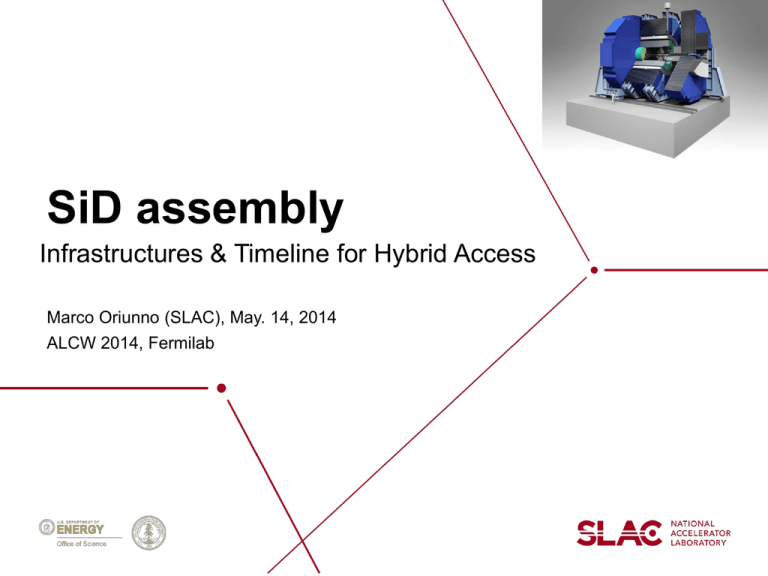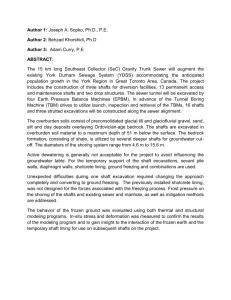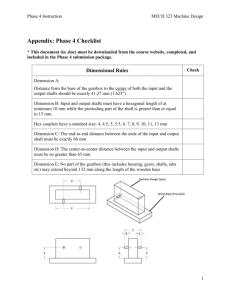MO_ALCW_14_Installation
advertisement

SiD assembly Infrastructures & Timeline for Hybrid Access Marco Oriunno (SLAC), May. 14, 2014 ALCW 2014, Fermilab SID key Features Physics requirements : Strong central field of 5 Tesla + Full Silicon Tracker + High Granularity Calorimetry -> Compact and Light Detector Push Pull requirements Self-shielded -> Monolithic Iron Barrel with, ~2.6 meter Iron thick Short L* (3.5 m) -> FFS Captured in the door • SID Outer Diameter 3 meter < than ILD • SID full length is half than CMS The Magnet drives the assembly procedure The Solenoid and the sectors of the Iron Magnet are the heaviest and largest parts. They have an envelope diameter of 7 meters and 3 meters respectively. Both are under 200 Tons. They dominate the construction logistic and the infrastructures requirements. 3 Lean assembly – Some Examples Airbus CMS Detector Shipbuilding 4 Construction and Assembly Strategy: 1. Construction and Testing of large sub-assemblies in remote sites (Institutes/Factories). 2. Checking after transport and pre-commissioning on Surface. 3. Complete the construction underground. • The iron of the magnet has a modular design with parts below 200 Tons, constructed at the factory and shipped to the site. The unit will be completed in situ with detectors (RPCs) and tested before they are moved in the Detector Hall • Because of the compact design of SID, the full weight of the Solenoid is well under 200 Tons. The two coils will be made at the factory, where they will installed in the Cryostat and shipped to the site before a low current check test, which will be eventually repeated before to move it in the Detector Hall. • All the detectors within the Solenoid diameter, Tracker, EMCAL and HCAL, will need appropriate infrastructures, therefore will be built and tested in remote Labs/Campus before being shipped to the site for the final installation. Assembly with the Hybrid Design Option #1: Vertical shafts Option #2: Horizontal Tunnel Option #3: Both access HT VT 6 Option #1: Vertical shafts The barrel and the doors are fully assembled on Surface and lowered through the main shaft, with the solenoid inside the barrel Calorimeters and Tracker through the Horizontal Tunnel with OD8m Infrastructure required by SID alone : 20 x 20 m2 Platform one 200 T capacity crane on surface one 4,000 T Gantry on the main shaft (to be shared with ILD) one 50 T crane underground Heavy Load Truck with a capacity of 50 T on < 10% slope • • • Cryogenics and Power Supplies required on surface if the Solenoid is commissioned to the full current. Two systems very likely required, one each detector. Not trivial if the Helium compressors are located underground (CMS has compressor and Helium storage on surface) 7 Option #1: Vertical shafts Option #1: Vertical Shaft, HCAL Installation Through the HT or a second shaft is required Option #1: Vertical shaft, comments 1. Large infrastructures on Surface 2. Handling of components with large mass and dimensions 3. A single shaft shared by both detectors, requiring a not trivial logistic with high infrastructures density. 4. HT still required for Inner Detector (HAC, ECAL, Tracker) 5. Require Cryogenics on Surface for commissioning. Inconsistent with the idea of compressors underground. Strategic advantage to full commission the Solenoid on surface and decouple the constructions of the Experimental Cavern and the Detector Assembly. But some of the benefits are lost because of a the point #3 and #4 10 Option #2: Horizontal Tunnel with OD8m Segments of the barrel and the doors with detectors are assembled on Surface and transferred through the horizontal tunnel. Solenoid assembled at the factory, burned in on surface and transferred through the horizontal tunnel. Full current commissioning only happen underground. Calorimeters and Tracker through the Horizontal Tunnel with OD8m Infrastructure required : one 200 T capacity crane on surface for SID One 50 Tons (my guess) capacity crane on surface for ILD one 2,000 T Gantry on the main shaft (only for ILD) one 200 T crane underground for SID and ILD Heavy Load Truck with a capacity of 200 T on < 10% slope * No Cryogenics required on Surface for SID 11 IR hall Specifications Helium Compressors 200 t + 20 t 11 m Surface 9m Loading Area 11m Beam line 1.1m 2.5m (0.5m Fe+2m concrete) 12 Access tunnel Beam tunnel 9m Dampimg Ring Access tunnel Large Part Heavy Part 13 Door Assembly on the platform 66 Tons • 11 trips from Surface /Door • 1 heavy lift / day Access Tunnel, Coil 15 Solenoid Installation 215 tons Crane Option #2: comments 1. Medium-large infrastructures 2. Handling of components with large mass and dimensions but gantry limited to 2,000 Tons 3. Heavy handling schedule decoupled for the detectors 4. Larger crane undergrounds 5. Doe not Require Cryogenics on Surface (at least for SID) 17 Handling of Large Weight CMS Lowering Start-to-End = 12 months for 11 large components < 2,000 Tons i.e. ~ 1 lowering/month Endcap 3 rings Endcap + 3 rings Barrel 5 rings 18 SID Options SID Option 1a = 3 components (2 x 2,500 T and 1 x 4,000 T) SID Option 1b = 5 components (2 x 2,500 T and 3 x 1,300 T) SID Option 2 = 40 components < 200 T 19 Schedules, Gantt Chart 5.5 Years t0 = 2025 Jan.2027 (t0+2yr) Sep.2026 (to+1.7yr) Aug.2026 (to+1.5yr) 20 Schedule, summary Cavern Construction t0 5.5 years < 200 Tons parts, Horizontal Tunnel 2,000 Tons parts, Single Shafts 4,000 Tons parts, Single Shafts t0 + 2 years t0 + 1.7 years t0 + 1.5 years 6 months lag 21 LHC = Vertical Shafts 22 LHC Schedule drivers 1. LHC was built inside the preexisting LEP tunnel. 2. The main schedule drivers were the removal of the LEP parts and the installation of the new magnets. 3. The CMS schedule challenges were because the cavern was built almost entirely, certainly true for the two new large shafts, versus an almost ready-to-go detector hall for ATLAS. 4. The ILC complex will be entirely built by scratch. 23 LHC IR layouts 3 shafts 4 shafts ATLAS, IP1 CMS, IP5 3 shafts 3 shafts ALICE, IP2 LHCb, IP8 24 ILC Schedule 4 years 25 Shafts versus Tunnel 1. Vertical shafts are an obvious solution for underground accelerator complex in flatlands (CERN) 2. Are less obvious in mountainous sites if the choice of short and flat tunnels is available Hyb. VS HT 26 Gran Sasso Lab = Horizontal Tunnel 27 Assembly Yard - CMS 34,000 m2 150 m 140 m 25 m Gas 1 Gas 2 He 223 m 28 SPS beam extraction - North area (CERN) 230 m 46 m 29 Kitakami Access Yard = one 50T crane + one 200T gantry 60,000 m2 Tunnel 30 Detector Units on cart + Pushback track 31 Transferring parts underground 32 Conclusion Large detector elements < 200Tons will be built remotely in Labs/Factories and shipped to the site. SID has developed assembly procedures compatible with Vertical Shafts, Horizontal Tunnels or a combinations. In the first case the schedule is only marginally shorter (few months) but with a non trivial heavy handling logistic on surface with a single shared main shaft. SID prefers the underground assembly through the horizontal tunnel of sufficient diameter OD8m and moderate slope. If horizontal tunnels become not possible, a second large shaft, one each detector, would be needed, which would also decrease the schedule risk. 33 EXTRA SLIDES 34 ILC Site 35 Assembly Yard - CMS 36 SPS beam extraction - North area (CERN) 37 Geology Study (CLIC geometry) ARUP +10 m Baseline Baseline + 10m Detector Hall Delivery before Detector Assembly 1. 2. 3. 4. Two Cranes < 215 tons, Platforms Minimum set of infrastructures (Power, Compr. Air, etc.) Pacmen can wait until detectors are ready






